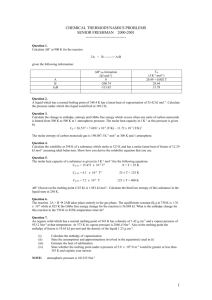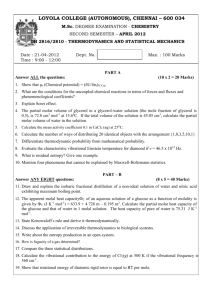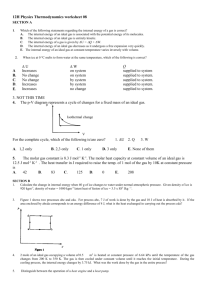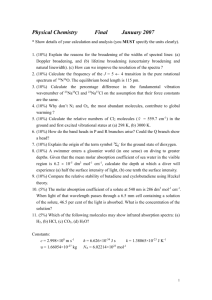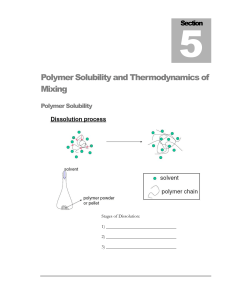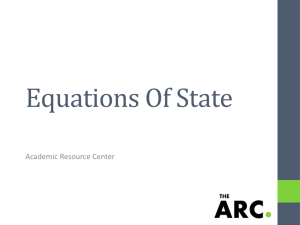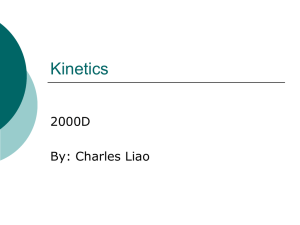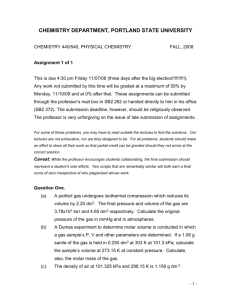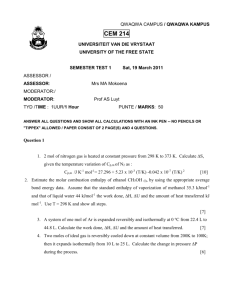COLAISTE NA hOLLSCOILE, CORCAIGH
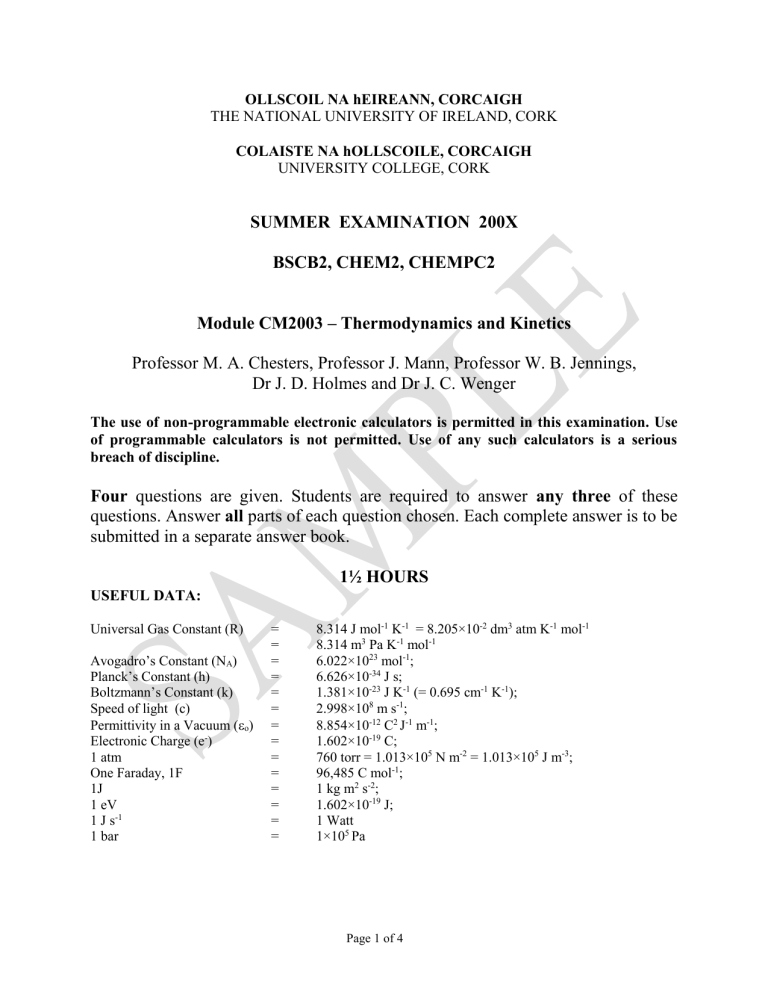
OLLSCOIL NA hEIREANN, CORCAIGH
THE NATIONAL UNIVERSITY OF IRELAND, CORK
COLAISTE NA hOLLSCOILE, CORCAIGH
UNIVERSITY COLLEGE, CORK
SUMMER EXAMINATION 200X
BSCB2, CHEM2, CHEMPC2
Module CM2003 – Thermodynamics and Kinetics
Professor M. A. Chesters, Professor J. Mann, Professor W. B. Jennings,
Dr J. D. Holmes and Dr J. C. Wenger
The use of non-programmable electronic calculators is permitted in this examination. Use of programmable calculators is not permitted. Use of any such calculators is a serious breach of discipline.
Four questions are given. Students are required to answer any three of these questions. Answer all parts of each question chosen. Each complete answer is to be submitted in a separate answer book.
1½ HOURS
USEFUL DATA:
Universal Gas Constant (R) =
=
Avogadro’s Constant (N
A
)
Planck’s Constant (h)
Boltzmann’s Constant (k)
=
=
=
Speed of light (c)
Permittivity in a Vacuum (
= o
) =
Electronic Charge (e ) =
1 atm =
One Faraday, 1F
1J
=
=
1 eV
1 J s -1
1 bar
=
=
=
8.314 J mol -1 K -1 = 8.205×10 -2 dm 3 atm K -1 mol -1
8.314 m 3 Pa K -1 mol -1
6.022×10 23 mol -1 ;
6.626×10 -34 J s;
1.381×10 -23 J K -1 (= 0.695 cm -1 K -1 );
2.998×10 8 m s -1 ;
8.854×10 -12 C 2 J -1 m -1 ;
1.602×10 -19 C;
760 torr = 1.013×10 5 N m -2 = 1.013×10 5 J m -3 ;
96,485 C mol -1 ;
1 kg m 2 s -2 ;
1.602×10 -19 J;
1 Watt
1×10 5 Pa
Page 1 of 4
QUESTION ONE
1 Answer all parts (i) to (iii)
(i) Define the terms internal energy (U), enthalpy (H) and molar heat capacity (C
M
). Under what conditions can the molar heat capacity be related to the internal energy change (ΔU) and the enthalpy change (ΔH) of a process?
[4 marks]
(ii) An ice cube at 0ºC weighing 100 g is dropped into 1 kg of water at 20ºC. Assuming that all of the ice melts show that the amount of energy adsorbed during this melting process is equal to 33.44 kJ. What is the final temperature of the water? The latent heat of fusion
(ΔH
FUS
) of ice at 0ºC is 6.025 kJ mol -1 and the molar heat capacity of water (C p, m
) is 75.3
J K
-1
mol
-1
. Assume that the total mass of water remains at 1 kg even after the addition of the ice.
[5 marks]
(iii) If 10 ice cubes (100 g each) are now added to 1 kg of water at 20ºC not all of the ice melts. How much ice remains? What is the entropy change (ΔS) associated with this process? Is the entropy change favourable? Assume that the total mass of water remains at 1 kg even after the addition of the ice.
Remember: ΔS
NET
= ΔS
1
+ ΔS
2
Where the net entropy change (ΔS
NET
) is equal to the entropy changes due to the reversible melting of ice at 0ºC (ΔS
1
) and the reversible cooling of 1 kg of water from
20ºC to 0ºC (ΔS
2
).
[11 marks]
QUESTION TWO
2 Answer all parts (i) to (iii)
(i) Define the terms heat (q) and work (w) and state function . Why are heat and work not state functions? Give an example of the property of a system which is a state function.
[4 marks]
(ii) 1 mole of gas at 100 K is compressed isothermally and reversibly from an initial volume of 20 dm
3
to a final volume of 5 dm
3
. Assuming the gas obeys the ideal gas equation calculate:
(a) the final temperature of the gas,
(b)
U, the increase in internal energy of the gas,
(c) w
REV
, the reversible work done by the gas,
(d) q, the heat absorbed by the gas,
(e)
H, the increase in enthalpy of the gas.
Page 2 of 4
QUESTION TWO: Continued…/
Remember :
Work done in an isothermal compression
V2
V1
P.dV
[7 marks]
(iii) In reality the gas in part (ii) of this question does not obey the ideal gas equation but instead obeys the equation of state given below:
P
RT
V
M
F
V 2
M
Where P is pressure (bar), R is the gas constant (8.314 J K
-1
mol
-1
), T is temperature (K),
V
M
is the molar volume of the gas (dm
3
mol
-1
) and F is a constant to account for the force of interaction between the gas molecules. For this gas F = 389 dm 6 bar mol -1 .
Based on this knowledge recalculate the reversible work done by the gas (w
REV
).
Compare you value to that obtained in part (ii) of this question and account for any difference.
[9 marks]
QUESTION THREE
3 Answer parts (i) and (ii)
(i) The following elementary reaction:
NO (g) + Cl
2
(g)
ClNO (g) + Cl (g) has an activation energy of 85 kJ mol
-1
and a standard enthalpy change of 83 kJ mol
-1
.
Draw a fully labelled potential energy diagram for the system and calculate the activation energy for the reverse reaction. Propose a structure for the activated species and indicate the importance of molecular orientation during the collision process.
[10 marks]
(ii) Given that the rate coefficient k = 0.2 dm 3 mol -1 s -1 , calculate the concentrations of Cl
2 and NO after 2 minutes if the reaction mixture had initial concentrations of [NO] = [Cl
2
]
= 0.1 mol dm
-3
. Calculate the initial rate of reaction and the rate after 2 minutes.
Comment on your answers.
Page 3 of 4
QUESTION FOUR
4 Answer all parts (i) to (iii)
(i) Briefly describe the method of initial rates for experimental determination of the order of a chemical reaction.
[4 marks]
(ii) The reaction
2NO
O
2
2NO
2 is thought to occur via the following mechanism
2NO
N
2
O
2
N
2
O
2
2NO
N
2
O
2
O
2
k
2NO
2
Assume [N
2
O
2
] to be in a steady state and derive the following;
d [ O
2
]
dt k
1 k
2
[ NO ]
2 k
1
k
2
[
[
O
O
2
]
2
]
[12 marks]
(iii) Write down a simpler expression for the rate of loss of O
2
given that k
-1
>> k
2
[O
2
].
[4 marks]
Page 4 of 4
